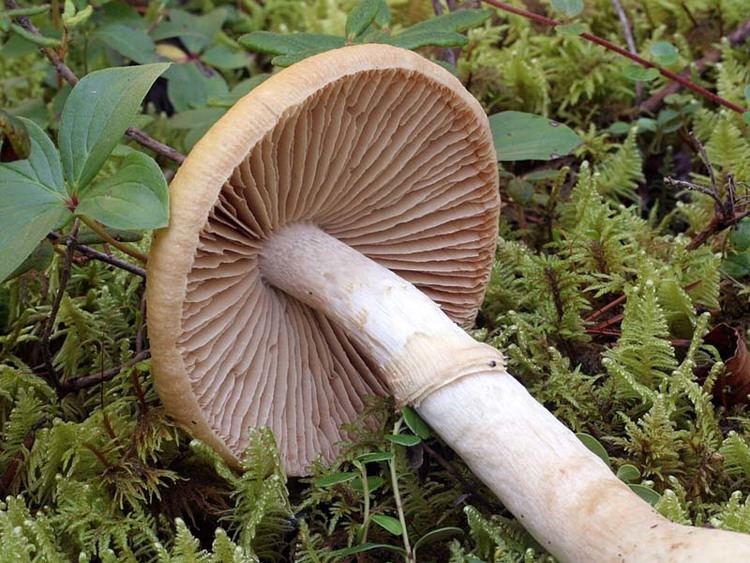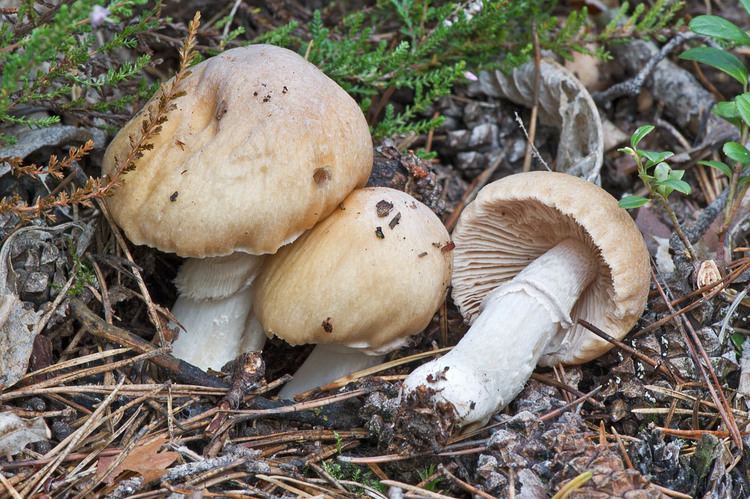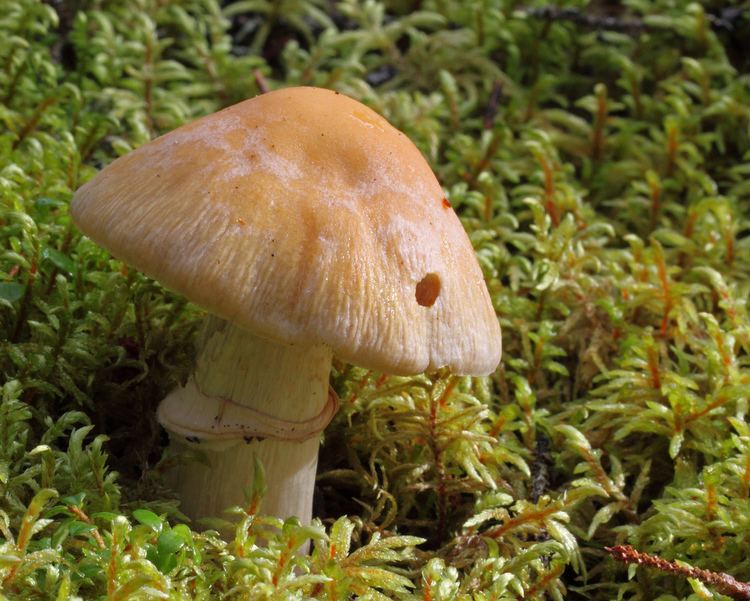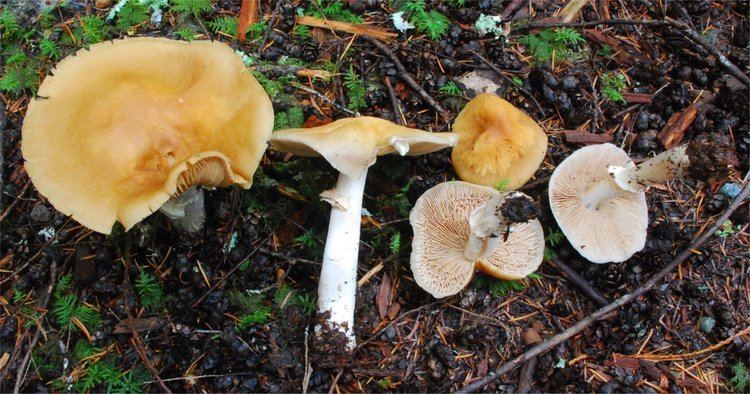Kingdom Fungi Order Agaricales | Division Basidiomycota Scientific name Cortinarius caperatus Rank Species | |
 | ||
Similar Cortinarius, Rozites, Kuehneromyces mutabilis, Suillus bovinus, Suillus grevillei | ||
Cortinarius caperatus
Cortinarius caperatus, commonly known as the gypsy mushroom, is a highly esteemed edible mushroom of the genus Cortinarius found in northern regions of Europe and North America. It was known as Rozites caperata for many years, before genetic studies revealed it lay within the large genus Cortinarius. The ochre-coloured fruiting bodies appear in autumn in coniferous and beech woods, as well as heathlands in late summer and autumn. The gills are free and clay-coloured and the smell and taste mild. Although mild-tasting and highly regarded, the gypsy mushroom is often infested with maggots.
Contents
- Cortinarius caperatus
- Hunting gypsy mushrooms cortinarius caperatus rozites caperata in the cascades
- Taxonomy
- Description
- Distribution and habitat
- Edibility
- Radioactivity
- References

Hunting gypsy mushrooms cortinarius caperatus rozites caperata in the cascades
Taxonomy

The gypsy mushroom has a checkered taxonomic history. It was originally described as Agaricus caperatus in 1796 by mycologist Christian Hendrik Persoon, who noted it grew in beech woods. The specific epithet caperatus is Latin for “wrinkled”. It was transferred to the genus Cortinarius by the Swedish mycologist Elias Magnus Fries. Later it was transferred to Pholiota in 1874 by Claude Casimir Gillet. This was followed by Pier Andrea Saccardo. The genus Rozites (after mycologist Ernst Roze) was established by Finnish mycologist Petter Adolf Karsten in 1879 to accommodate the species on the basis of the mushroom having a double veil, and it was known as Rozites caperata (Pers.) P. Karst. for many years. The variant Rozites caperatus was and is also sometimes seen, but this may be a mistake.

Genetic analysis in 2000 and 2002 showed that the genus Rozites was not a discrete group and its members were nested within Cortinarius, and that the gypsy mushroom was closely related to the New Zealand species Rozites meleagris and R. castanella. Hence it was once more placed within Cortinarius.
Common names include the gypsy mushroom, and wrinkled rozites. An unusual common name is granny′s nightcap in Finland.
Description

Cortinarius caperatus has a buff to brownish-ochre cap 5–10 cm (2–4 in) diameter, which is covered with whitish fibres. The surface has a wrinkled and furrowed texture. It may have a lilac tinge when young. It is convex initially before expanding and flattening with a boss in the centre. The stipe is 4–7 cm (1.6–2.6 in) high and 1–1.5 cm (0.4–0.6 in) thick and slightly swollen at the base, and is whitish with a whitish ring, which is initially attached to the cap. The free gills, are clay-coloured; the spores give an ochre-brown spore print. The warty almond-shaped spores measure 10–13 × 8–9 µm. The flesh is cream-coloured and the taste mild.

Similar-looking North American species include Agrocybe praecox, which lacks the wrinkled cap, and is found in cultivated areas, and Phaeolepiota aurea, which has powdery-granular surface. In central Europe, old specimens could be mistaken for the highly poisonous Inocybe erubescens in summer, and young mushrooms for the inedible Cortinarius traganus, although the latter is readily distinguished by its unpleasant odour.
Distribution and habitat

It is found across northern Europe, mainly in Scandinavia. In the British Isles it is uncommon outside the Scottish Highlands and the New Forest. It is widely found in northern parts of North America. Cortinarius caperatus is found in subarctic areas of western Greenland; it is rare, growing in association with white birch (Betula pubescens). The gypsy mushroom also grows in temperate Asia, i.e. it can be found on the markets in the Tibetan areas of Yunnan and Sichuan and also in Bhutan. In addition to the gypsy mushroom, in the Tibeto-Himalayan region the Himalayan Gypsy (Cortinarius / Rozites emodenis), a close relative with a purple hue, is also commonly eaten and frequently traded.
Fruiting bodies sprout from August to October in conifer and beech woods, as well as heather (often close by sphagnum) in Scotland. It is mycorrhizal but non-selective in its hosts. It prefers sandy soils and avoids chalky ones, and may be found in the same habitats as Boletus badius, Paxillus involutus, and chanterelles. It forms relationships with Pinus sylvestris. It is often found near huckleberry in North America.
Edibility
Cortinarius caperatus is a highly regarded edible mushroom with a mild flavour. It is said to mix well with stronger-flavoured fungi such as chanterelles, boletes, brittlegills or milk-caps. However, picked mushrooms are often infested with maggots. Mycologist David Arora recommends discarding the tough stipes. It can be dried for later use readily. It is sold commercially in Finland.
Radioactivity
This mushroom is known to hyperaccumulate heavy metals from its environment. Following the Chernobyl disaster, resulting in radioactive contamination in countries as distant as Scandinavia, health authorities in these countries caution against overconsumption of C. caperatus.
As some species of fungi - among others the gypsy mushroom, enrich more radioactivity from the soil than other species the Chernobyl nuclear disaster still form a risk of elevated radioactivity in the gypsy mushrooms in many countries throughout Europe.
